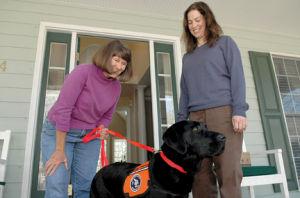 CEDAR POINT — Christine Goodier, a 66-year-old travel writer who is totally deaf in one ear and nearly deaf in the other, has learned to navigate life without hearing sounds most people take for granted.
CEDAR POINT — Christine Goodier, a 66-year-old travel writer who is totally deaf in one ear and nearly deaf in the other, has learned to navigate life without hearing sounds most people take for granted.
She has depended mainly on others, such as her husband, to alert her to sounds associated with daily tasks such as answering the door when someone knocks. But as her deafness has worsened, it’s becoming increasingly difficult.
“At home my husband has to tell me when the microwave or dryer beeps. I accidentally locked my husband out one time and didn’t hear him knocking to get in,” she said.
But that’s all about to change thanks to a 2-year-old black Labrador retriever named Raylene. Mrs. Goodier just received Raylene, a hearing dog from Dogs for the Deaf Inc., a national hearing dog training and placement service in Central Point, Ore.
Hearing dogs are trained to alert people to household sounds that are necessary for everyday safety and independence. They are trained to make physical contact with their owner and lead them to the source of the sound.
They also serve to alert owners when they are out in public to people and activities that may be going on behind and around them. When the dog turns to look at something it hears, the person will notice and turn to see what’s happening, as well.
Dogs for the Deaf trains dogs to assist people with hearing loss, as well as autism and other challenges. Most of the dogs are trained after being rescued from animal shelters, but some also come from individual owners and organizations, according to Carrie Brooks, a certified assistance dog trainer who delivered Raylene to her new owner Wednesday.
Once a person is matched with a dog, a certified trainer delivers the dog and works with the new owner and dog for five days.
“We also do a lot of extensive follow up once a dog is placed,” said Ms. Brooks Thursday as she worked with Mrs. Goodier at her home.
Mrs. Goodier said she already knows she made the right decision.
“I’m thrilled,” she said. “It’s really indescribable what I feel having the dog. The dog just doesn’t have a great personality, but she’s already alerting me if someone comes to the door.”
Mrs. Goodier, who travels extensively in a recreational vehicle with her husband, said she learned about the organization in November 2012 when she attended a Good Sam Club rally in Raleigh.Good Sam Club, which provides support and discount services to RV travelers, presented a program on Dogs for the Deaf during the rally. The club also sponsors dogs for deaf individuals.
Dogs for the Deaf depends on outside donors to support their work. Other than a small application fee, all hearing dogs are placed with qualified applicants free of charge.
After hearing the presentation, Mrs. Goodier began to research the organization and decided it was the right way for her to go. She applied for a dog in August 2013.
She contacted the Good Sam Club, who agreed to pay the $25,000 cost to purchase a dog.
After going through an extensive application process, which includes sending medical records, and a home visit by a Dogs for the Deaf representative, she was approved for a dog. While it normally takes a year to find a match, Mrs. Goodier was contacted in January 2014 that a match was found.
“As a dog is about to complete training we begin to look for a match that will be a good client for that particular dog,” said Ms. Brooks. “Some dogs are mainly dogs that stay at home because the owners don’t want to take them into public. In Christine’s case, she wanted a dog that could travel with her.”
Ms. Brooks said Raylene was donated to her organization by Guide Dogs for the Blind, a group that trains dogs for the blind. Many dogs don’t make the final cut for the blind after going through extensive training and medical examinations. In Raylene’s case, she had a type of cataract that excluded her from being a guide dog. However, Ms. Brooks said, the type of minor cataract condition she has won’t worsen and made her a perfect candidate as a hearing dog.
“I started working with Raylene in April 2013 and the training normally takes four to six months,” said Ms. Brooks.
While Raylene was donated by an organization, most of the group’s dogs come from animal shelters in Oregon and California. Ms. Brooks said trainers go to shelters and look for dogs with certain characteristics
“They have to be people friendly, comfortable in a kennel, and we watch how they react to loud noise and sudden movement,” she said. “And they can’t have people fears.”
Once a dog is accepted into the program, Ms. Brooks said the organization makes a lifetime commitment to that dog. If it turns out they don’t make the final cut after being trained, they are placed in a good home.
Ms. Brooks said the organization, which is the largest hearing dog organization in the nation, began in 1977. More than 1,000 dogs have been placed since it started.
But none of that would be possible without support of donors and sponsors. Ms. Brooks said donations and sponsors are always welcome, as are applications from individuals interested in obtaining a dog.
~Via Carolina Coast Online
Tags: assistance dogs, Dogs for the Deaf, hearing dogs, service dog
